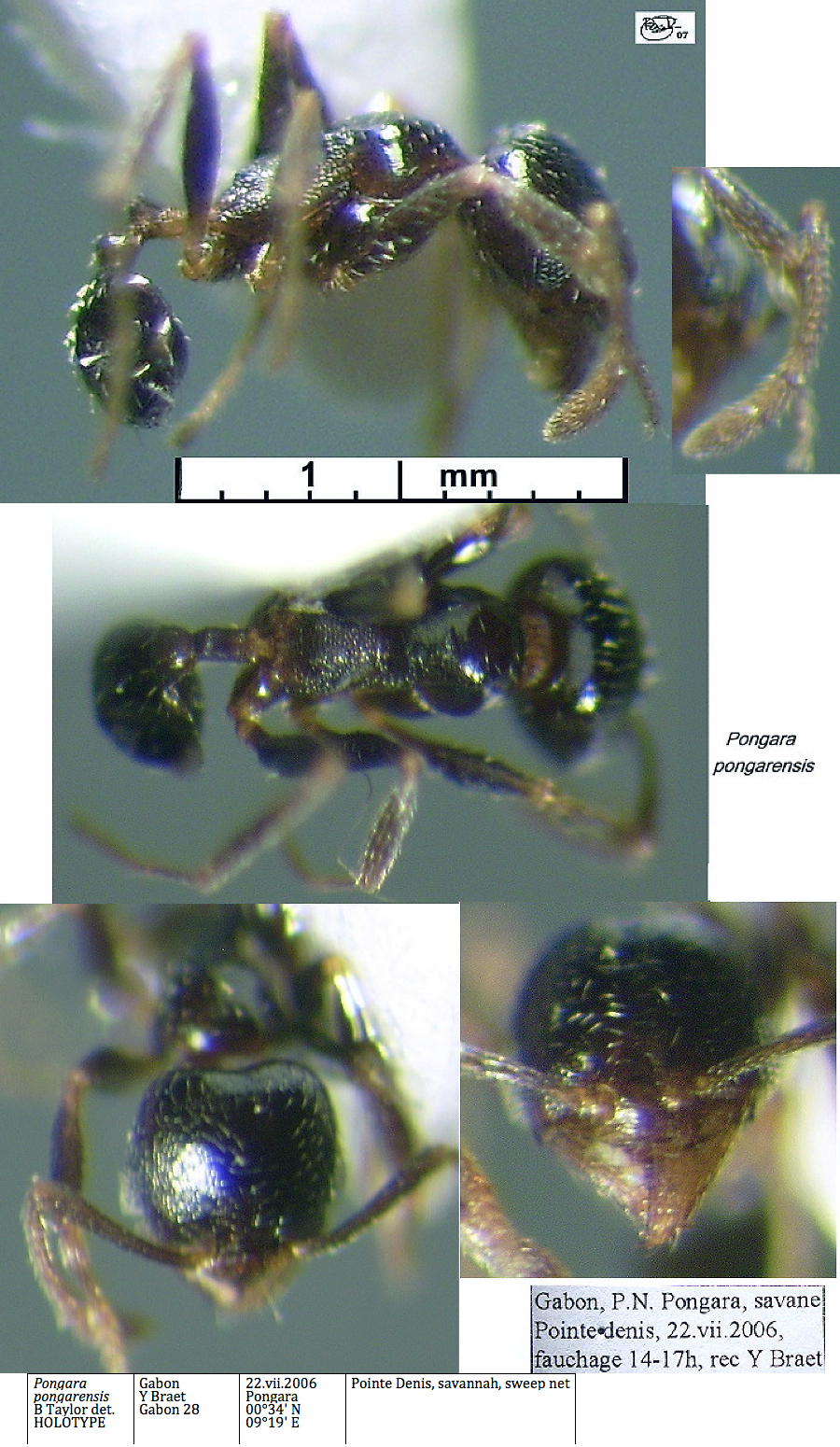Pongara Taylor & Braet new genus
Type species Pongara pongarensis new species
Taylor & Braet
In Tribe PHEIDOLINI (?) - the original definition of
Pheidolini (Emery, 1877a: 72) was based solely on the queen.
Diagnostic Features - in full-face view head
weakly cordiform. Head unusually large relative to the alitrunk. In
frontal view the head shape is reminiscent of Rhoptromymrex
species but members of that genus all have small eyes set behind the
mid-point of the face. Eyes, large and ovoid, shallowly convex, set
close to the anterior margin of the head, wholly anterior to the
mid-point of the sides and on the sides of the head, the dorsum of the
head being quite strongly convex. Mandibles subtriangular, dentate with
a row of coarse peg-like teeth on the internal margin, apparently
without a noticeably larger apical tooth. Median portion
of clypeus projecting slightly over the basal borders of the mandibles
when fully closed; anterior border weakly impressed medianly; possibly
weakly bicarinate; anterior border with two pairs of long stout setae
projecting forward, these are downcurved in lateral view; posterior
margin shallowly arcuate. Frontal carinae cover condylar bulbs but are
only faintly visible beyond that point. No distinguishable frontal
notch. No ocelli visible. Dorsum of head with no erect pilosity but
sparse coarse pubescence. Underside of head with several quite long
hairs. Wholly shiny but with weak striation on frontal area and weak
spiculation between the frons and the eyes.
Antenna similar in form to most Pheidole minors;
12-segmented with a 3-segmented club; scape barely reaching the
occiput (most if not all Pheidole
minors have the scape surpassing the occiput). Scape with a distinct
basal curve then thickening
progressively to the apex, with moderate decumbent pubescence.
Funiculus in total slightly longer than the scape.
Promesonotum evenly domed, pronotum wholly shiny,
mesonotum spiculate, weakly so on the dorsum. Propodeum with sloping
dorsum and a very weakly angular transition into the sloping declivity,
wholly unarmed; propodeal spiracle small, circular and set close to
upper angle. Alitrunk without any erect hairs but sparse decumbent
pubescence.
Pedicel of Pheidole form, with petiole profile a
fairly low, narrow node, the anterior face a long curve, a distinct
dorsum which slopes down to the near vertical posterior face, in dorsal
view narrow and parallel-sided, also with a convex ventral process;
postpetiole small and globular in all views; both nodes largely
unsculptured.
Gaster much smaller than head or alitrunk, with first
segment much larger than the rest combined, wholly shiny, with sparse
semi-erect short hairs.
TL ca 1.7 mm; HW 0.48, HL 0.51, CI 88; SL 0.40, SI
91, PW 0.39, OI (eye length/HW) 0.30
|
 HOLOTYPE specimen worker only found. Collected at
Pongara National Park, Gabon, by sweep netting in savannah; by
Yves Braet, 22.vii.2006, 1400-1700 h. HOLOTYPE specimen worker only found. Collected at
Pongara National Park, Gabon, by sweep netting in savannah; by
Yves Braet, 22.vii.2006, 1400-1700 h.
Pongara is situated in the
Estuary Province (Province de l'Estuaire) across the Komo Estuary from
the capital Libreville; at 0°34'N-9°19'E.
Specimen deposited in the Oxford University Museum of
Natural History.
Following the standard keys to Myrmicinae from Africa
(e.g. Bolton, 1994) ends at Pheidole. I have been able to
compare it with the minors of over 50 African Pheidole and Pongara
pongarensis is quite distinct from all, apart from the
superficially similar minor worker of Pheidole
termitophila but that has no sculpturation on the head and short, sharp, propodeal spines.
Other images can be seen in the folder at - 
|